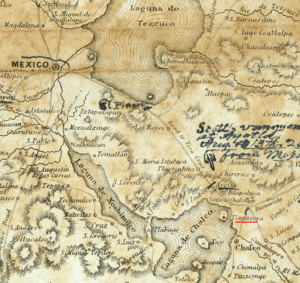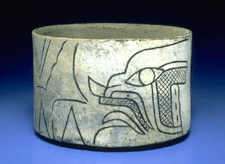Tlapacoya (archeological site) facts for kids
Tlapacoya is an important archaeological site in Mexico. It is found at the base of the Tlapacoya volcano. This spot is southeast of Mexico City, right where Lake Chalco used to be. Tlapacoya was a big center for the ancient Tlatilco culture.
People know Tlapacoya especially for its amazing small statues, called Tlapacoya figurines. These clever clay figures were usually made between 1500 and 300 BCE. They show the art style of the Preclassic Period.
Tlapacoya also made special "Dragon Pots." These are round bowls with flat bottoms. They have white or light brown surfaces. On them, you can see carved drawings in the style of the Olmec people. These drawings often show creatures that look like half-jaguar, half-human, called were-jaguars.
Contents
Discovering Ancient Tlapacoya
Besides the figurines and other items from 1500 to 300 BCE, scientists found something even older. They discovered human and animal bones. Some of these bones might be as old as 25,000 years!
Clues from Long Ago
The most talked-about discoveries at Tlapacoya are artifacts that some experts say are from 25,000 years ago. If this is true, these would be some of the oldest signs of people living in the Americas. This would change what we thought about when humans first came to the New World.
The proof for these very old dates includes bones from black bears and two types of deer. These bones were found in ancient trash piles, called middens. These piles were near old campfires, called hearths, from about 22,000 years ago.
They also found a curved blade made of obsidian. Obsidian is a sharp, glassy rock. This blade was found under a buried tree trunk. The bones were dated to around 24,000 years ago. The tree trunk was also about 24,000 years old. The obsidian blade itself was dated using a special method to between 21,250 and 25,000 years ago.
A Freeway's Discovery
This important site was found when workers were building a freeway between Mexico City and Puebla. Sadly, much of the site has been covered or changed by the freeway construction since then.
In 1955, a woman named Beatriz Barba studied Tlapacoya. She was the first Mexican woman to become an archaeologist. Her study looked at how the Tlatilco culture developed and their religious customs. Beatriz Barba was one of the first to study the daily life, trade, and how other groups influenced the Tlatilco people at Tlapacoya.
Ancient Human Bones
Scientists like Silvia González have also found human remains at Tlapacoya. One skull from Tlapacoya is the first human bone in Mexico to be directly dated. It is about 9,730 years ago.



